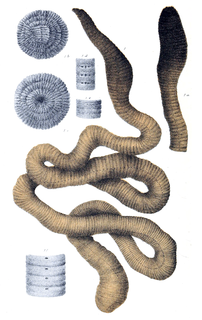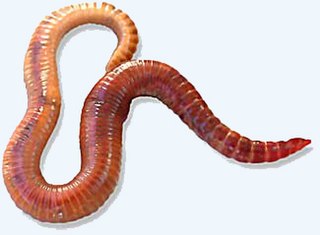
Lumbricus terrestris is a large, reddish worm species thought to be native to Western Europe, now widely distributed around the world. In some areas where it is an introduced species, some people consider it to be a significant pest for out-competing native worms.

The Lumbricidae are a family of earthworms. About 33 lumbricid species have become naturalized around the world, but the bulk of the species are in the Holarctic region: from Canada and the United States and throughout Eurasia to Japan. An enigmatic species in Tasmania is Eophila eti. Currently, 670 valid species and subspecies in about 42 genera are recognized. This family includes the majority of earthworm species well known to Europeans.

Oligochaeta is a subclass of animals in the phylum Annelida, which is made up of many types of aquatic and terrestrial worms, including all of the various earthworms. Specifically, oligochaetes comprise the terrestrial megadrile earthworms, and freshwater or semiterrestrial microdrile forms, including the tubificids, pot worms and ice worms (Enchytraeidae), blackworms (Lumbriculidae) and several interstitial marine worms.

The Megascolecidae is a taxonomic family of earthworms which is can be found native in Madagascar, in Australia, New Zealand and both South East Asia and North America. All species of Megascolecidae belong to the Clitellata class. Megascolecidae are a large family of earthworms and they can grow up to 2 meters in length. The intercontinental distribution of Megascolecidae helps in favouring the Continental Drift theory.

The giant Gippsland earthworm, Megascolides australis, is one of Australia's 1,000 native earthworm species.

Eisenia fetida, known under various common names such as manure worm, redworm, brandling worm, panfish worm, trout worm, tiger worm, red wiggler worm, etc., is a species of earthworm adapted to decaying organic material. These worms thrive in rotting vegetation, compost, and manure. They are epigean, rarely found in soil. In this trait, they resemble Lumbricus rubellus.

The Kinabalu giant earthworm, Pheretima darnleiensis, is a grey-blue coloured peregrine annelid. It is found widely in Southeast Asia, primarily in the Indo-Australasian Archipelago, but also in Peninsular Malaysia. Records from the Caroline Islands and Fiji are believed to represent introductions This also applies to the eponymic Darnley Island record.
Anisochaeta gigantea, commonly called the North Auckland worm, is a rare giant annelid of the family Megascolecidae, endemic to New Zealand.
The Oregon giant earthworm is one of the largest earthworms found in North America, growing to more than three feet in length. First described in 1937, the species is not common. Since its discovery, specimens have been documented in only fifteen locations within Oregon's Willamette Valley.
The Acanthodrilidae are an ancient and widely distributed family of earthworms which has native representatives in Australia, New Zealand, South Africa, South America, and North America. No native species are known from India nor Asia. The family possibly shows a pre-Pangaean distribution.

An earthworm is a terrestrial invertebrate that belongs to the phylum Annelida. They exhibit a tube-within-a-tube body plan; they are externally segmented with corresponding internal segmentation; and they usually have setae on all segments. They occur worldwide where soil, water, and temperature allow.
Earthworms are invasive species throughout the world. Of a total of about 6,000 species of earthworm, about 120 species are widely distributed around the globe. These are the peregrine or cosmopolitan earthworms. Some of these are invasive species in many regions.

Gregor William Yeates, publishing as GW Yeates, was a New Zealand soil zoologist and ecologist. He was "considered the world's leading authority in soil nematode ecology, a subject of economic and ecological importance."

Dendrodrilus rubidus is a species of earthworm in the family Lumbricidae. It is native to Europe, and it is a widespread introduced species, occurring on every continent except Antarctica, as well as many islands. It is often invasive. It is sometimes used as fishing bait, and is marketed under many nonspecific names, including red wiggler, jumping red wiggler, red trout worm, jumbo red worm, and pink worm. Other common names include bank worm, tree worm, and gilt tail.
Samuel James is an American scientist, a researcher specializing in evolutionary biology, focusing on earthworm taxonomy. James, with fellow researchers, has discovered numerous species of annelids, including Diplocardia californiana, Diplocardia woodi, Diplocardia montana, and a new species related to the Giant Palouse earthworm.
Octochaetus is a genus of earthworms of family Octochaetidae native to Australia, New Zealand, and Malaysia.

Allolobophora chlorotica, commonly known as the green worm, is a species of earthworm that feeds and lives in soil. This species stands out from other earthworms due to the presence of three pairs of sucker-like discs on the underside of the clitellum. An examination of A. chlorotica specimens from many parts of the British Isles suggests that there are two forms of this species, one with green pigment in the body wall, and one which lacks this pigment, making it pink.

Amynthas mekongianus, the Mekong worm or Mekong giant earthworm, previously known as Megascolex mekongianus, is a species of earthworm in the family Megascolecidae. It is native to the vicinity of the River Mekong in southeastern Asia and may have more than 500 segments and grow to a length of 2.9 m (10 ft).
Megascolecidae earthworm Amynthas japonicus was a Japanese native probably collected from Nagasaki in the 1820s. It was one of three native earthworms featured in Dr P.F.B. von Siebold’s extensive collection and recorded as one of Japan’s earliest pheretimoid species. It is now deemed extinct given that a 2018 Nagasaki expedition and earlier 1930s reports failed to locate it. It is featured on The Recently Extinct Plants and Animals Database.

Octolasion lacteum is a species of earthworm of the genus Octolasion. In New Zealand it has been found in West Coast soils and in Canterbury. They are found in mostly moist areas deep under the soil as they feed in the nutrients within the soil. Unlike other worm species, these are known to survive in acidic soil as well as soil that is not as organic compared to other places. They provide some important roles in the ecosystem as well as threats to other species as well. After a drought, they help the soil get more organic by adding more carbon dioxide in the soil and the waste from the O. lacteum also provides nutrients for the soil. In another case, they can also be invasive in a way that they suck up carbon in the soil which means plants have less causing a disruption to the food web. Lastly, they reproduce by cross parthogenic reproduction.










